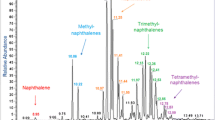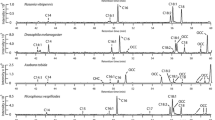Abstract
A new method has been developed for the determination of fatty acids, sterols, and other lipids which naturally occur within pupae of the blow fly Phormia regina. The method relies upon liquid extraction in non-polar solvent, followed by derivatization using N,O-bis(trimethylsilyl)trifluoroacetamide (BSTFA) w/ 1% trimethylchlorsilane (TMCS) carried out inside the sample vial. The analysis is facilitated by total vaporization solid-phase microextraction (TV-SPME), with gas chromatography-mass spectrometry (GC-MS) serving as the instrumentation for analysis. The TV-SPME delivery technique is approximately a factor of five more sensitive than traditional liquid injection, which may alleviate the need for rotary evaporation, reconstitution, collection of high performance liquid chromatography fractions, and many of the other pre-concentration steps that are commonplace in the current literature. Furthermore, the ability to derivatize the liquid extract in a single easy step while increasing sensitivity represents an improvement over current derivatization methods. The most common lipids identified in fly pupae were various saturated and unsaturated fatty acids ranging from lauric acid (12:0) to arachinoic acid (20:4), as well as cholesterol. The concentrations of myristic acid (14:0), palmitelaidic acid (16:2), and palmitoleic acid (16:1) were the most reliable indicators of the age of the pupae.

Blow fly pupae were extracted prior to emerging as adults. The extracts were analyzed via total vaporization solid-phase microextraction (TV-SPME), revealing a complex mixture of lipids that could be associated with the age of the insect. This information may assist in determining a post-mortum interval (PMI) in a death investigation






Similar content being viewed by others
References
Zhang ZY, Pawliszyn J. Headspace solid-phase microextraction. Anal Chem. 1993;65(14):1843–52. doi:10.1021/jf960835m.
Zhang ZY, Yang MJ, Pawliszyn J. Solid-phase microextraction. Anal Chem. 1994;66(17):A844–53. doi:10.1021/ac00089a001.
Rainey CL, Bors DE, Goodpaster JV. Design and optimization of a total vaporization technique coupled to solid-phase microextraction. Anal Chem. 2014;86(22):11319–25. doi:10.1021/ac5030528.
Bors D, Goodpaster JV. Mapping explosive residues on galvanized pipe bomb fragments using total vaporization solid-phase microextraction (TV-SPME). Anal Methods. 2015;7:9756–62. doi:10.1039/c5ay02358k.
Lotspeich E, Kitts K, Goodpaster J. Headspace concentrations of explosive vapors in containers designed for canine testing and training: theory, experiment, and canine trials. Forensic Sci Int. 2012;220(1–3):130–4. doi:10.1016/j.forsciint.2012.02.009.
Sauzier G, Bors D, Ash J, Goodpaster JV, Lewis SW. Optimisation of recovery protocols for double-base smokeless powder residues analysed by total vaporisation (TV) SPME/GC-MS. Talanta. 2016;158:368–74. doi:10.1016/j.talanta.2016.04.048.
Telles-Romero R, Toledo J, Hernández E, Quintero-Fong JL, Cruz-López L. Effect of temperature on pupa development and sexual maturity of laboratory Anastrepha obliqua adults. Bull Entomol Res. 2011;101(5):565–71. doi:10.1017/S0007485311000150.
Peeters C, Monnin T, Malosse C. Cuticular hydrocarbons correlated with reproductive status in a queenless ant. Proc R Soc B-Biol Sci. 1999;266(1426):1323–7.
Roux E, Sreng L, Provost E, Roux M, Clement JL. Cuticular hydrocarbon profiles of dominant versus subordinate male Nauphoeta cinerea cockroaches. J Chem Ecol. 2002;28(6):1221–35. doi:10.1023/a:1016237918662.
Bland JM, Osbrink WLA, Cornelius ML, Lax AR, Vigo CB. Detection of termite cuticular hydrocarbons by solid-phase microextraction (SPME). Sociobiology. 2003;41(1A):91–104.
Bland JM, Osbrink WLA, Cornelius ML, Lax AR, Vigo CB. Solid-phase microextraction for the detection of termite cuticular hydrocarbons. J Chromatogr A. 2001;932(1–2):119–27. doi:10.1016/s0021-9673(01)01239-0.
De Pasquale C, Guarino S, Peri E, Alonzo G, Colazza S. Investigation of cuticular hydrocarbons from Bagrada hilaris genders by SPME/GC-MS. Anal Bioanal Chem. 2007;389(4):1259–65. doi:10.1007/s00216-007-1503-9.
Villaverde ML, Girotti JR, Mijailovsky SJ, Pedrini N, Juarez MP. Volatile secretions and epicuticular hydrocarbons of the beetle Ulomoides dermestoides. Comp Biochem Physiol B-Biochem Mol Biol. 2009;154(4):381–6. doi:10.1016/j.cbpb.2009.08.001.
Farine JP, Ferveur JF, Everaerts C. Volatile drosophila cuticular pheromones are affected by social but not sexual experience. PLoS One. 2012;7(7):e40396. doi:10.1371/journal.pone.0040396.
Baker JE, Nelson DR, Fatland CL. Developmental changes in cuticular lipids of the black carpet beetle, Attagenus megatoma. Insect Biochemistry. 1979;9(3):335–9. doi:10.1016/0020-1790(79)90015-5.
Frere B, Suchaud F, Bernier G, Cottin F, Vincent B, Dourel L, et al. GC-MS analysis of cuticular lipids in recent and older scavenger insect puparia. An approach to estimate the postmortem interval (PMI). Anal Bioanal Chem. 2014;406(4):1081–8. doi:10.1007/s00216-013-7184-7.
Yoder JA, Blomquist GJ, Denlinger DL. Hydrocarbon profiles from puparia of diapausing and nondiaposing flesh flies (Sarcophaga crassipalpis) reflect quantitative rather than qualitative differences. Arch Insect Biochem Physiol. 1995;28(4):377–85. doi:10.1002/arch.940280407.
Golebiowski M, Bogus MI, Paszkiewicz M, Stepnowski P. Cuticular lipids of insects as potential biofungicides: methods of lipid composition analysis. Anal Bioanal Chem. 2011;399(9):3177–91. doi:10.1007/s00216-010-4439-4.
Golebiowski M. Comparison of free fatty acids composition of cuticular lipids of Calliphora vicina larvae and pupae. Lipids. 2012;47(10):1001–9. doi:10.1007/s11745-012-3702-1.
Gołębiowski M, Boguś MI, Paszkiewicz M, Wieloch W, Włóka E, Stepnowski P. The composition of the cuticular and internal free fatty acids and alcohols from Lucilia Sericata males and females. Lipids. 2012;47(6):613–22. doi:10.1007/s11745-012-3662-5.
Golebiowski M, Paszkiewicz M, Grubba A, Gasiewska D, Bogus MI, Wloka E, et al. Cuticular and internal n-alkane composition of Lucilia sericata larvae, pupae, male and female imagines: application of HPLC-LLSD and GC/MS-SIM. Bull Entomol Res. 2012;102(4):453–60. doi:10.1017/s0007485311000800.
Golebiowski M, Cerkowniak M, Bogus MI, Wloka E, Przybysz E, Stepnowski P. Developmental changes in the sterol composition and the glycerol content of cuticular and internal lipids of three species of flies. Chem Biodivers. 2013;10(8):1521–30. doi:10.1002/cbdv.201200419.
Golebiowski M, Sosnowska A, Puzyn T, Bogus MI, Wieloch W, Wloka E, et al. Application of two-way hierarchical cluster analysis for the identification of similarities between the individual lipid fractions of Lucilia sericata. Chem Biodivers. 2014;11(5):733–48. doi:10.1002/cbdv.201300294.
Golebiowski M, Urbanek A, Oleszczak A, Dawgul M, Kamysz W, Bogus MI, et al. The antifungal activity of fatty acids of all stages of Sarcophaga carnaria L. (Diptera: Sarcophagidae). Microbiol Res. 2014;169(4):279–86. doi:10.1016/j.micres.2013.07.011.
Zhu GH, Xu XH, Yu XJ, Zhang Y, Wang JR. Puparial case hydrocarbons of Chrysomya megacephala as an indicator of the postmortem interval. Forensic Sci Int. 2007;169(1):1–5. doi:10.1016/j.forsciint.2006.06.078.
Frederickx C, Dekeirsschieter J, Brostaux Y, Wathelet JP, Verheggen FJ, Haubruge E. Volatile organic compounds released by blowfly larvae and pupae: new perspectives in forensic entomology. Forensic Sci Int. 2012;219(1–3):215–20. doi:10.1016/j.forsciint.2012.01.007.
Blomquist GJ, Soliday CL, Byers BA, Brakke JW, Jackson LL. Cuticular lipids of insects: V. Cuticular wax esters of secondary alcohols from the grasshoppers Melanoplus packardii and Melanoplus sanguinipes. Lipids. 1972;7(5):356–62. doi:10.1007/bf02532655.
Soliday CL, Blomquist GJ, Jackson LL. Cuticular lipids of insects. VI. Cuticular lipids of the grasshoppers Melanoplus sanguinipes and Melanoplus packardii. J Lipid Res. 1974;15(4):399–405.
Zhu GH, Ye GY, Hu C, Xu XH, Li K. Development changes of cuticular hydrocarbons in Chrysomya rufifacies larvae: potential for determining larval age. Med Vet Entomol. 2006;20(4):438–44. doi:10.1111/j.1365-2915. 2006.00651.x.
Golebiowski M, Cerkowniak M, Bogus MI, Wloka E, Dawgul M, Kamysz W, et al. Free fatty acids in the cuticular and internal lipids of Calliphora vomitoria and their antimicrobial activity. J Insect Physiol. 2013;59(4):416–29. doi:10.1016/j.jinsphys.2013.02.001.
McNaught AD, Wilkinson A. IUPAC. Compendium of Chemical Terminology (the "Gold Book"). Blackwell Scientific Publications. XML on-line corrected version. 1997. http://goldbook.iupac.org.
Folch J, Lees M, Sloane Stanley GH. A simple method for the isolation and purification of total lipides from animal tissues. J Biol Chem. 1957;226(1):497–509.
Peters FT, Drummer OH, Musshoff F. Validation of new methods. Forensic Sci Int. 2007;165:216–24.
Boyd RK, Basic C, Bethem RA. Trace quantitative analysis by mass spectrometry. Hoboken: John Wiley & Sons; 2008.
Shrivastava A, Gupta VB. Methods for the determination of limit of detection and limit of quantitation of the analytical methods. Chronicles of Young Scientists. 2011;2(1):21–5.
Ingle J, James D, Crouch SR. Introduction to Molecular Spectroscopy. In: Spectrochemical Analysis. Prentice Hall, Englewood Cliffs; 1988. pp 325–351.
Kranz W, Carroll C, Dixon DA, Goodpaster JV, Goodpaster JV, Picard CJ, et al. Factors affecting species identifications of blow fly pupae based upon chemical profiles and multivariate statistics. Insects. 2017;8(2):43.
Acknowledgements
The authors acknowledge the American Chemical Society Project SEED program for financial support of Mr. Dixon. This work was made possible by the National Institute of Justice (Contract 2013-DN-BX-K019). The opinions and conclusions expressed do not necessarily reflect those of the aforementioned organizations.
Author information
Authors and Affiliations
Corresponding author
Ethics declarations
Conflict of interest
The authors declare that they have no conflict of interest.
Rights and permissions
About this article
Cite this article
Kranz, W., Carroll, C., Dixon, D. et al. Optimization of total vaporization solid-phase microextraction (TV-SPME) for the determination of lipid profiles of Phormia regina, a forensically important blow fly species. Anal Bioanal Chem 409, 6349–6357 (2017). https://doi.org/10.1007/s00216-017-0573-6
Received:
Revised:
Accepted:
Published:
Issue Date:
DOI: https://doi.org/10.1007/s00216-017-0573-6




